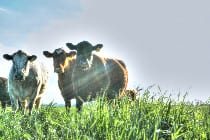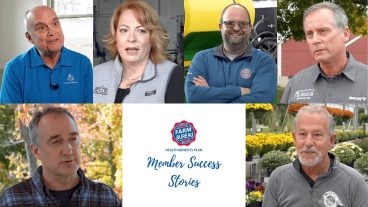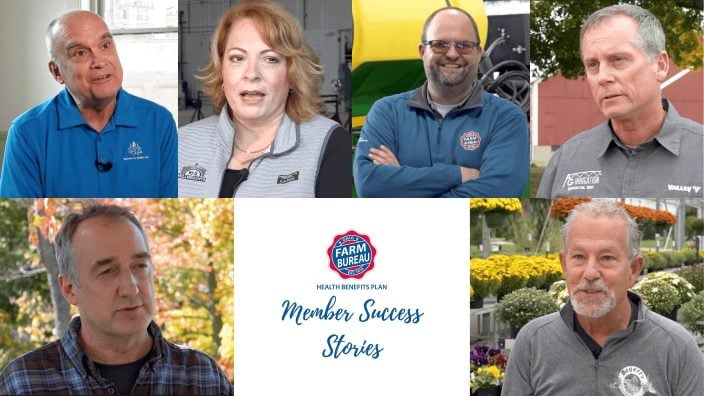Farmer’s Guide to Trucking Regulations available to Ohio Farm Bureau members
The guide includes a farm driver checklist, overview of state and federal regulations and exemptions, CDL qualifications and more.
Read More
Katie Esselburn from Wayne County is the editor of the May 20, 2019 Growing our Generation enewsletter, featuring insights and ideas directly from Ohio’s young farmers and food and agricultural professionals.
Greetings fellow agriculturalists! I’m Katie Esselburn from Wayne County, raised to know how to grow the best steak on earth but I inherited a passion for the dairy industry from both sets of grandparents. I’ve been fortunate to work my entire career in the dairy industry, and currently work with the team at WG Dairy Supply in Creston, as farm management support advisor for Lely milking robots. I live near my home farm where I was raised, and together with my family work a cow-calf beef operation and grow soybeans, wheat and corn.
 After finishing my master’s degree at Ohio State, my first job took me about three hours away from home. Digging into the feed industry and learning nutrition was challenging and rewarding, but when the opportunity arose for me to transition working locations back to Wayne County a few years later, I jumped on it. Last week I was reminded why continuing to help at the home farm had to be a non-negotiable part of my life:
After finishing my master’s degree at Ohio State, my first job took me about three hours away from home. Digging into the feed industry and learning nutrition was challenging and rewarding, but when the opportunity arose for me to transition working locations back to Wayne County a few years later, I jumped on it. Last week I was reminded why continuing to help at the home farm had to be a non-negotiable part of my life:
“You have to move quick for him, Katie. He’s kind of sneaky.” My dad was rounding the far side of the barn as I plotted my approach to the small and innocent looking 80-pound bull calf penned up with his mama.
We needed to apply the castration band before releasing him to the open pasture. I sidled calmly up to this little calf tagged 19-43, hoping to win his affections with my gentle demeanor. My hand barely brushed the hairs on his backside before he shot off, and in a blink he was at the other end of the pen.
“Why didn’t you tell me he was fast?” I joked with my dad. I tried again, this time taking the no-nonsense approach, catching his head. 19-43 really wasn’t in the mood for that either, so with all the grace my mother bestowed upon me, I flopped on top of him. This calf must have had some sort of amphibious genetics, because he started trying to swim through the straw to put a little more distance between him and me. I thought maybe I’d snagged a mustang instead of a nine-day-old calf, his back hooves churning up straw.
After all that ruckus, we finally got the job done and released the pair into the pasture. About this time, the sun had just set below the trees to the west, and the soft glow of stars on a clear spring night shown in the pale blue evening sky among the sliver of silver moon. The hum of the tractor operated by my little brother in the field behind the barn was barely audible, the smell of freshly churned dirt permeating the damp night air as we watched cows munch on their fresh patch of rye pasture. In the calm of the twilight, we loaded back up into Dad’s red pickup truck just in time to hear the end of the Cleveland Indians baseball game, the cherry on top being a walk off home run for the home team heralded ecstatically by our beloved Tom Hamilton. Rodney Atkins’ lyrics fit the moment: “If this ain’t heaven it’s halfway there.”
 On our small operation, my family and I work together to make things work between the off-farm job hours. Our goals and visions for the future are central to our family discussions, and plenty of hard work happens in between. Making my career work with being back at the farm wasn’t always easy or clear, but the path was forged and I get to be involved in our piece of production agriculture as an adult. As families who work together know, sometimes you bump heads and disagree, but we always come back together at the Sunday dinner table, pray over our meal, and take the time to appreciate the family and farming we have in our lives.
On our small operation, my family and I work together to make things work between the off-farm job hours. Our goals and visions for the future are central to our family discussions, and plenty of hard work happens in between. Making my career work with being back at the farm wasn’t always easy or clear, but the path was forged and I get to be involved in our piece of production agriculture as an adult. As families who work together know, sometimes you bump heads and disagree, but we always come back together at the Sunday dinner table, pray over our meal, and take the time to appreciate the family and farming we have in our lives.
 One of the most ubiquitous challenges in our industry today is labor shortage. Dairy farmers rely heavily on hired labor to milk the cows, at least twice a day but more often farms are running a three-times-a-day milking rotation. If workers fail to show up for any reason, the cows still need milked, like clockwork. When unemployment rates run as low as they are currently, dairy farmers notice, mostly because people stop knocking on the door looking for work. For many, working outside among animals is an undesirable mode of employment, although I could never understand trading that “fresh country air” for anything else. Add in the complex political environment of maintaining a legal workforce, and it’s easy to see how hiring and keeping good employees around can be a drain on financial resources and time.
One of the most ubiquitous challenges in our industry today is labor shortage. Dairy farmers rely heavily on hired labor to milk the cows, at least twice a day but more often farms are running a three-times-a-day milking rotation. If workers fail to show up for any reason, the cows still need milked, like clockwork. When unemployment rates run as low as they are currently, dairy farmers notice, mostly because people stop knocking on the door looking for work. For many, working outside among animals is an undesirable mode of employment, although I could never understand trading that “fresh country air” for anything else. Add in the complex political environment of maintaining a legal workforce, and it’s easy to see how hiring and keeping good employees around can be a drain on financial resources and time.
 Robotics have provided one solution to the labor issue industrywide. During my leadership training with the AgriPOWER Institute, we visited a carrot farm in Arizona. The plant manager described to us that robotics had helped them reduce their labor force requirements by over 60%; this was huge for them just keeping their doors open, because they were having great difficulty in finding the massive number of people that they needed during harvest season.
Robotics have provided one solution to the labor issue industrywide. During my leadership training with the AgriPOWER Institute, we visited a carrot farm in Arizona. The plant manager described to us that robotics had helped them reduce their labor force requirements by over 60%; this was huge for them just keeping their doors open, because they were having great difficulty in finding the massive number of people that they needed during harvest season.
I’ve witnessed firsthand the pains of labor shortages for dairy producers. They’re not exactly new technology (milking robots have been researched for over 60 years), but now I’m able to watch firsthand how Lely milking robots have changed lives, both the life of the cow and life of their caretakers. Other automation includes scraping, which can be performed by automatic alley scrapers, or Lely’s Discovery robot (imagine a highly sophisticated manure Roomba). Even feeding can be robotic, from automatic calf feeders to automated TMR systems, and although these “kitchens” have yet to gain popularity in the U.S., the concept holds promise.
We’ve only scratched the surface on how to apply the use of robotics on farms, not to mention the data waiting to be mined from these technologies, much of which is automatically collected. Every farm is unique in its approach to managing its animals, but when there’s a fit that helps farmers become more profitable, animals to perform better, or the production of a high-quality product is maintained congruent with adapted technologies, it’s worth exploring the options. Agriculture continues to be an amazingly versatile industry for applying technological advancement in new and innovative ways every day.
 If you’re coming from Wooster, it’s a quick trip down SR 95, through the bustling metropolis of Funk – watch out for the frogs crossing the road to get to the “better” side of the swamp – and a few turns and dog legs down the back roads will land you at Esselburn Grain and Cattle Farm. Many of you can probably give similar directions to your own farms, but it never ceases to amaze me that despite the remote locations and freedom as far as the eye can see, we can be bound together in an instant from Hong Kong to, say, Funk, with just a swipe across a screen. Ease in communication has prompted an attitude of expectation from the public eye in terms of transparency in production agriculture.
If you’re coming from Wooster, it’s a quick trip down SR 95, through the bustling metropolis of Funk – watch out for the frogs crossing the road to get to the “better” side of the swamp – and a few turns and dog legs down the back roads will land you at Esselburn Grain and Cattle Farm. Many of you can probably give similar directions to your own farms, but it never ceases to amaze me that despite the remote locations and freedom as far as the eye can see, we can be bound together in an instant from Hong Kong to, say, Funk, with just a swipe across a screen. Ease in communication has prompted an attitude of expectation from the public eye in terms of transparency in production agriculture.
We are living through one of the largest anthropologic shifts in history where just 2% of the US population is directly involved with production agriculture, and that downward trend is appearing on a global scale as well, a topic addressed well during Vance Crowe’s keynote speech at this year’s YAP conference. Kids are growing up without ever having to get up before school to help do chores and take care of their 4-H projects – an experience my father adamantly, and gleefully, insured my brothers and I did not miss by shaking us from our beds in the early morning. I reflect on the summer hours with my mother in her garden with orders to weed the green beans or stake tomatoes. Whether this was done in a timely manner depended on the squirrelliness of her children that day.
Point being, these chores at the farm didn’t just give me a front row seat to the game: I was playing on the team. The value I obtained from my upbringing has allowed me to never have to ask the question, “Where does my food come from?” I already knew, because I helped grow it.
When people outside of the ag industry ask me questions about my career or the family farm, I used to tense up with apprehension, fearful and mistrusting of the purpose behind the question. What I’ve come to realize is that people simply haven’t experienced food production. Don’t be afraid to engage in conversations, listen patiently, and show your passion. It can be a humbling experience trying to explain a normal, and to you, mundane agricultural practice to a complete stranger, then walking away from the conversation knowing that they didn’t understand a word you said. Keep practicing, keep reaching out. AgriPOWER Institute and YAP offer many opportunities to hone communication and leadership skills; always find ways to keep learning about the industry you love.
SUBSCRIBE to receive Growing our Generation, a biweekly eletter with a different featured editor to meet each issue. Browse the archive of past issues.
This e-newsletter is brought to you by Ohio Farm Bureau’s Young Ag Professionals. Learn more about Farm Bureau membership, including a discounted category for those 18-24 years old.


The guide includes a farm driver checklist, overview of state and federal regulations and exemptions, CDL qualifications and more.
Read More


ODA will enroll 500,000 acres into the program for a two-week sign-up period, beginning April 22, 2024, through May 6, 2024. Contact local SWCD offices to apply.
Read More

Katie Share of Columbus has been named ExploreAg and Youth Development Specialist for Ohio Farm Bureau.
Read More

Mary Klopfenstein of Delphos has been named Young Ag Professional and Ag Literacy Program Specialist for Ohio Farm Bureau.
Read More

The plan has been updated to give sole proprietors access to more rate stability and a smart solution that offers potential savings on health care.
Read More

The American Farm Bureau Federation, in partnership with Farm Credit, is seeking entrepreneurs to apply online by June 15 for the 2025 Farm Bureau Ag Innovation Challenge.
Read More

Adele Flynn of Wellington has been elected treasurer of the Ohio Farm Bureau Federation and now holds the third highest elected office in Ohio’s largest and most influential farm organization.
Read More

Producers are urged to work with their veterinarian to practice enhanced biosecurity measures and review and limit cattle movements within production systems.
Read More

The changing seasons bring with them the need to thoroughly inspect pole barns for any damages that may have occurred during the winter months.
Read More

Hundreds of Ohio businesses and sole proprietors are raving about Ohio Farm Bureau’s Health Benefits plan with lower, predictable costs and easy enrollment and administration options.
Read More